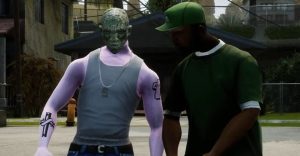Stephen King’s IT: Why The Book Ending Makes The Creature Even More Confusing

Throughout Stephen King’s It, Pennywise is referred to as a male, but author Stephen King pulled a fast one on readers in the book’s ending by revealing the creature’s true form was a pregnant spider, implying that it is, in fact, biologically female. So why has Pennywise exclusively been played by male actors in It‘s television and movie adaptations? And is the character actually male, female, or something else entirely?
Pennywise was always going to be a difficult character to bring to life, as there are many confusing elements around his mythos. The shapeshifting creature terrorized the residents of Derry, Maine every 27 years by taking on the form of that they fear the most. The story’s central group, the Losers’ Club figures out that Pennywise has the power to do this because he’s an extra-terrestrial creature that’s millions of years old. So in a way, Pennywise’s origins almost allow him to transcend gender norms altogether.
It is such a dense book that many details needed to be let go for the television and movie adaptations — Pennywise’s fluid gender and complex mythology happened to be part of those changes. The reveal of Pennywise’s pregnancy may have been an important moment in the book, but there’s a simple reason it was never shown on the screen. It would’ve just been too difficult to explain.

It’s clearly established in the novel that Pennywise most commonly appears to the Losers in the shape of a clown. As the creature is referred to as “he” in this form, it can be assumed that the clown is male. Since that clown is Pennywise’s most common form, it makes sense that both adaptations would depict him as a clown. So naturally, it would make sense for a male actor to be cast in the role of Pennywise in light of the book’s pregnancy reveal. In fact, neither adaptation of It felt the need to defend or comment on their decision to cast a male actor to play Pennywise — it just seemed like the obvious choice. Since It’s spider form pregnancy was left out of both movies and the TV miniseries, it wasn’t a detail that needed further examination unless people are familiar with the book ending.
While bringing the killer clown to life on screen was simple, there were plenty of elements of the novel that simply were not. It is more than 1,100 pages long, and movie and television adaptations always need to condense their source material to make sure they work for the screen. So, parts of It had to go. King’s novel famously gets a little out there — a prime example being that Pennywise’s enemy is a giant turtle. In order to be commercially successful, both adaptations needed to cut details that were too weird or confusing. Suddenly revealing that a male clown was actually a pregnant spider creature in the end of It would have certainly confused the audience.
However, 2019’s It Chapter Two dropped a number of Easter eggs referring to the details from the book that had to be cut, proving that the adaptation respected its roots and fans of the original story even though it didn’t always explain the more confusing elements of King’s story in detail.
About The Author
















